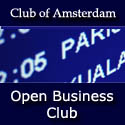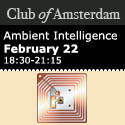
Welcome to the Club of Amsterdam Journal. “In the Critique of Pure Reason Kant argues that the unity of consciousness cannot be understood in terms of the contents of experience. But he also argues, in effect, that it cannot be understood in terms of the unity of the self as a thing in itself either. This Kantian dilemma has a modern descendant: there are difficulties for both subjective and objective accounts of the unity of consciousness. ” – Susan L. Hurley, Department of Philosophy, University of Warwick (UK) “The experience of consciousness is entirely subjective. The paradox, however, is that despite the indubitable reality of our subjectivity and thousands of years of philosophical examination, there is little consensus on what consciousness is. Science, with its characteristic third-person method – the objective perspective from the outside – has made strikingly little headway in this understanding.” – Dalai Lama Join our discussion about the future of Consciousness on January 25 |
The Future of Consciousness
 | by Arjan Kindermans, Managing Director, EnlightenNext Amsterdam |
How does consciousness develop? This is a fascinating question. Consciousness. Pure subjectivity. Awareness. We all know it exists. That is why you are able to read this piece, for example. Yet scientists aren’t able to find it. You can’t locate it. Consciousness is not a ‘thing’. It is what everything appears in. It is not the seen but the seeing itself. Now, talking about the evolution of consciousness gets even trickier. Here we are talking about the development of that which everything appears within and not about the development of all the things that we can see.
Since we made it from cells via bacteria, fish, mammals, primates, primitive peoples, medieval citizens to modern humans, something is definitely developing, and it isn’t just our tools. We are becoming increasingly conscious; how we see ourselves, how we see the world and how we interpret what we see, is all developing. Recently that development has sped up tremendously. We went into space and saw the earth from above for the first time. We started connecting with people from all over the world through the Internet. We are now getting news from anywhere, literally within minutes. We have been evolving both technologically and psychologically; we left behind old values and dogmas. Many of us freed ourselves from the ties of tradition and religion and decided for ourselves what we believe in. We are more conscious now, and we started focusing that greater awareness on ourselves. We have become our own highest value, and that is what we seem to have gotten stuck in. As positive as it is – the individuality that is such a high value in our culture has made possible many things that were impossible before – yet the attachment to our individuality, to the image we have of ourselves, our cultural narcissism, makes moving to the next stage in our evolution very difficult.
Many people have stated that the crisis we are in now is a spiritual one that it is our consciousness that needs to change. As one of Albert Einstein’s most quoted aphorisms states: you can’t solve problems with the same level of thinking that created them. So we have to leap. We have to shift to a higher level. I am passionately interested in finding out how to do that and, more importantly, in actually doing that. In Andrew Cohen‘s philosophy, called Evolutionary Enlightenment, my interests in spirituality and evolution came together and I found it opened up the previously unthinkable possibility of consciously creating the future; to be an agent for and expression of the process of evolution that, consciously or not so consciously, we are all part of.
Arjan Kindermans is a speaker at our event about the future of Consciousness
Thursday, January 25, 2007
18:30 – 21:15
News about the future of Consciousness

The Online Experiments Portal
Rupert Sheldrake invites you to participate in his ongoing research. No previous experience is necessary, and the online tests can be done immediately. Most of these experiments are suitable for use in schools and colleges, and some make an excellent basis for student projects.
Rupert Sheldrake, iconoclast, biologist, and author of The Sense of Being Stared At, brings his inquisitive, scientific mind to the exploration of intuition, precognition, and telepathy.

New Brain Cells
Fred Gage is a neuroscientist at the Salk Institute for Biological Studies in La Jolla, California. Gage’s lab showed that, contrary to accepted dogma, human beings are capable of growing new nerve cells throughout life. Small populations of immature nerve cells are found in the adult mammalian brain, a process called Neurogenesis. Gage is working to understand how these cells can be induced to become mature functioning nerve cells in the adult brain and spinal cord. They showed that environmental enrichment and physical exercise can enhance the growth of new brain cells and they are studying the underlying cellular and molecular mechanisms, that may be harnessed to repair the aged and damaged brain and spinal cord.
Club of Amsterdam blog
 | Club of Amsterdam blog December 18: selflead December 14: On the Art of Value-Webbing October 26: Synthesis of elBulli cuisine October 14: The new Corinthians: How the Web is socialising journalism |
News about the Future

Learning Retinal Implant System
The Learning Retinal Implant System is an adaptive visual prosthesis – an “artificial retina” – that bridges and replaces the defective information processing function of the real retina in patients with retinal degeneration. It thus enables blind people to regain modest visual perception and a sense of orientation even in unfamiliar surroundings. The Retinal Implant is expected to improve the quality of life of this group of patients significantly and permanently.

KishKish Lie Detector offers you a tool to detect the stress level of the person you talking with over Skype. With the use of KishKish Lie Detector you can monitor in real-time the stress level of the person you talked with. This allows you to gage the level of stress and modify your questions in real time. You could also use our KishKish SAM VSA that allows you to record the call and analyze the stress level off-line.
Researchers found that frequencies in the human voice are sensitive to honesty. When a person is being honest the average sound in that range is generally in the lower frequencies, but is usually higher in dishonest situations. Some people have high average stress levels, and some have low, and averages changes from day to day along with mood. What all people have in common is that their stress levels are constantly changing within their current range, changes which indicate the “perceived jeopardy” or “danger” of statements being made. A lie is often dangerous, humiliating, or injurious to get caught at, so lies tend to stand out on stress measurements.
Next Season Event
 | the future of Consciousness Thursday, January 25, 2007 Registration: 18:30-19:00, Conference: 19:00-21:15 Where: EnlightenNext, Oudeschans 46a, 1011 LC Amsterdam Mauk Pieper, Trainer, Coach, Teacher Cultural development and the development of man as a new more conscious being have to go hand in hand. Arjan Kindermans, EnlightenNext Amsterdam Transcending and including individualism, how do you do that? George Pór, Founder, CommunityIntelligence Ltd. What Color is Your Collective Intelligence? Moderated by Lisette Thooft, Author, free lance journalist     Supporter  |
Recommended Book

Earthdance
by Elisabet Sahtouris, James E. Lovelock
An evolution biologist’s story of planet Earth and its people from origins to a sustainable future. Past patterns of biological evolution offers clues to the natural process of globalization.
“This book is a work of philosophy in the original sense of a search for wisdom, for practical guidance in human affairs through understanding the natural order of the cosmos to which we belong. It bears little resemblance to what we have come to call philosophy since that effort was separated from natural science and became more an intellectual exercise in understanding than a practical guide for living.
To find meaning and guidance in nature, I integrated my personal experience of it with those scientific accounts that seemed to best fit it. From this synthesis, meaning and lessons for humanity emerged freely. I wrote the original version in the peaceful, natural setting of a tiny old village on a small pine-forested Greek island, where I could consider the research and debates of scientists, historians, and philosophers, then test them against the natural world I was trying to understand.”
The evolutionary significance of spiritual development
The evolutionary significance of spiritual development
by John Stewart
Are we organisms that are forever constrained by their biological and cultural past? Or can we become self-evolving beings — organisms that are able to adapt in whatever directions are necessary for future evolutionary success, relatively unfettered by our evolutionary past or by our previous life experiences?
This article argues that humans can develop such a capacity to transcend human nature, and that the next great evolutionary challenge for humanity is to do so. The paper suggests that the practices and tools that will enable humanity to make this transition are to be found in the practices and teachings of the world’s religious and spiritual traditions. There is an urgent need to integrate these into modern scientific psychology.
Evolutionary adaptability
Adaptability is of central importance to the evolutionary process. It is through adaptation that organisms are able to survive in changing environments, become better suited to their existing environment, or expand into new environments. In general, organisms that are more adaptable can be expected to be more successful in evolutionary terms. A major improvement in adaptive ability is a major evolutionary advance.
Humans are the most adaptable organism to live on this planet. We use our rapidly improving science and technology to survive and satisfy our adaptive goals in a wide range of environments. Whatever adaptive problem we put our minds to, we can generally find a solution. We have proven far more adaptable than organisms that evolve by gene-based evolution. It took millions of years for genetic evolution to discover how to produce reptiles that fly, while humans developed the technology to achieve this in a few thousand years. The massive adaptive improvements seen in human capacities over recent centuries are significantly greater than could be achieved by genetic evolution over hundreds of millions of years.
Whatever our wants, whatever our needs, we are very effective at finding ways to manipulate our environment to achieve them. But we are very poor at achieving things that we do not want. We don’t use our creativity to find better ways to achieve things we are not motivated to achieve. In evolutionary terms, this turns out to be the central limitation in human adaptability.
Typically we do not see this as a limitation. It does not prevent us from doing anything that we want to do. It does not stop us from living happy and fulfilled lives. We do not feel restricted because we have no desire to do what we have no desire to do. If we evaluate our adaptability by asking whether it enables us to satisfy our needs and wants, we continue to see ourselves as being highly adaptable.
But if we measure our adaptive ability in evolutionary terms, we reach a very different conclusion. What if our continued evolutionary success demands that we adapt in ways that conflict with the satisfaction of our existing needs and wants? What if our existing motivations and needs do not produce the behaviours that are best in evolutionary terms? These sorts of conflicts between our needs and evolution’s needs seem highly likely to emerge during our evolutionary future. It is improbable that the needs and wants implanted in us by our evolutionary past will produce the behaviour that is also optimal for our future. This means that our adaptability is seriously limited in evolutionary terms.
There is an enormous range of behaviours, life styles and technologies that we would not want given our current needs and motivations. But these might be critically important for achieving evolutionary success in the future. We have a very large evolutionary blind spot. We are not motivated to explore an immense variety of adaptive possibilities, no matter how useful they may be in evolutionary terms. Until we overcome this limitation, we will continue to use genetic engineering, artificial intelligence and other technological advances to satisfy our past evolutionary needs and conditioning, rather than to achieve future evolutionary success.
If we are to be successful in evolutionary terms in the future, we will need to overcome this adaptive limitation. We will have to be able to do whatever it takes for future success. Humanity will need to free itself from the needs and wants installed in us by our biological and cultural past. For this we will find that we will need to develop in ways that have traditionally been classified as spiritual. Humanity will need to widely adopt the practices currently associated with spiritual development if we are to continue to be successful in evolutionary terms.
To get a better understanding of how human adaptability would need to change in the future, it is useful to see how adaptability has improved during the past evolution of life on Earth. This will enable us to locate the current level of human adaptability within a long sequence of evolutionary improvements. We will see how our current level surpassed previous abilities, but how it too is limited. This will help identify the new capacities we would have to develop if we are to overcome these limitations. It will point to the new psychological skills and capacities we need if we are to overcome our current deficiencies.
[…]
The future
Until we humans develop the capacity to free ourselves from our biological and cultural past, our evolutionary adaptability will be seriously constrained. We will not use the enormous potential of mental modelling to identify and implement the actions that will contribute most to the evolutionary success of humanity. Instead of using our technological advances and economic resources for evolutionary goals, we will continue to use them only to serve the needs and wants established by our evolutionary past and conditioning. Humanity will continue to spend its time on this planet masturbating stone age desires, going nowhere in evolutionary terms.
Alternatively we could massively enhance our evolutionary adaptability by freeing ourselves from the dictates of our biological and cultural past. We could develop the ability to align our internal reward and motivation system with evolutionary goals. This would enable us to find satisfaction and motivation in whatever adaptations serve these goals. With this capacity we could choose to implement whatever actions would advance the evolutionary success of humanity, and would find satisfaction and motivation in doing so. This would enable us to use the immense power of mental modelling to pursue evolutionary goals, rather than continue to blindly pursue outdated and inaccurate proxies for evolutionary success as ends in themselves.
If we make this transition, humans would become self-evolving beings, able to adapt in whatever directions are necessary for future evolutionary success, relatively unfettered by our biological past or by our previous life experiences. As we move out into the solar system, the galaxy and the universe, we would be able to change our adaptive goals and behaviour in whatever ways were demanded by the challenges we meet. We would be able to continually recreate ourselves, to change human nature at will, to repeatedly sacrifice what we are for what we can become, to continually die and be born again.
Read the full report click here

Unique venue for training and workshops
Looking for an attractive venue for a training, meeting or presentation? We offer you a beautiful, quiet space with a pleasant atmosphere in the centre of Amsterdam. The characteristic building is situated along one of the canals in walking distance from Central Station, metro and parking garage.
.
Lifelong Kindergarten
Lifelong Kindergarten
“The Lifelong Kindergarten group is fortunate to be located within the MIT Media Lab, a hotbed of creative activity. In one corner of the Media Lab, students are designing new musical instruments. In another corner, students are designing new social-networking software. This type of activity makes the Media Lab not just a good research lab, but a good place for learning, since people learn a great deal when they are actively engaged in designing, creating, and inventing things.
Unfortunately, most children don’t get the opportunity to engage in these types of creative activities. In school, they learn specific facts and skills, but rarely get the opportunity to design things –- or to learn about the process of designing things. Outside school, they interact with electronic toys and games, but they don’t learn how to invent new ones.
In the Lifelong Kindergarten group, we’re trying to change that. We believe that it is critically important for all children, from all backgrounds, to grow up knowing how to design, create, and express themselves. We are inspired by the ways children learn in kindergarten: when they create pictures with finger paint, they learn how colors mix together; when they create castles with wooden blocks, they learn about structures and stability. We want to extend this kindergarten style of learning, so that learners of all ages continue to learn through a process of designing, creating, experimenting, and exploring.
Our ultimate goal is a world full of playfully creative people who are constantly inventing new opportunities for themselves and their communities.” – Mitchel Resnick
Some Projects
Computer Clubhouse
At Computer Clubhouse after-school centers, young people (ages 10-18) from low-income commmunities learn to express themselves creatively with new technologies. Clubhouse members work on projects based on their own interests, with support from adult mentors. By creating their own animations, interactive stories, music videos, and robotic constructions, Clubhouse members become more capable, confident, and creative learners.
Scratch
Scratch is a new programming environment that kids can use to create their own animated stories, video games, and interactive art — and share their creations with one another across the Internet.
To create Scratch programs, kids snap together graphical building blocks, each representing a different command or action. Kids learn important computational ideas as they transform images, mix in sound clips and drum beats, and integrate inputs from real-world sensors.
Scratch is designed especially for use at Computer Clubhouses and other after-school centers, empowering young people (ages 8-18) to express themselves fluently and creatively with new technologies.
Crickets
Crickets are small programmable devices that can make things spin, light up, and play music. You can plug lights, motors, and sensors into a Cricket, then write computer programs to tell them how to react and behave. With Crickets, you can create musical sculptures, interactive jewelry, dancing creatures, and other artistic inventions — and learn important math, science, and engineering ideas in the process.
Invention Kits for Kids
We are developing the next generation of invention kits for kids, expanding the range of what kids can design, create, and invent. This project builds on our previous work on programmable-brick technologies, which led to the LEGO MindStorms and PicoCricket products. One new goal: to radically reduce the cost of these technologies, so that they become accessible to more children around the world.
What’s Up
What’s Up is a telephone-based, neighborhood news system that makes it easier for youth to collect, share, and analyze information about personally meaningful places, people, and opportunities in their neighborhoods. By dialing a central number, youth can send and receive personal messages, publish community announcements, create voicemail groups, and find out what is happening in their communities. We expect that appropriate use of the What’s Up system will help to increase awareness of and accessibility to important local youth resources, provide youth with opportunities to express their opinions about the places where they live and, with that, contribute to the development of communities that are both friendlier and empowering for young people.
Agenda

2-days LABs in Girona, Spain, moderated by Humberto Schwab:
LAB on Old and New ENERGY, April 17/18, 2007
LAB on MEDIA and Human Experience, May 29/30, 2007

Our Season Events for 2006/2007 are on Thursdays: |
| the future of Tourism May 31, 2007, 18:30 – 21:15 Location: Info.nl, Sint Antoniesbreestraat 16, 1011 HB Amsterdam [Next to Nieuwmarkt] SPECIAL SEASON EVENT Taste of Diversity June 28, 2007 Location: PricewaterhouseCoopers, Thomas R. Malthusstraat 5, 1066 JR Amsterdam [Near metro stop Henk Sneevlietweg] This evening has two parts: – The Conference: Registration: 18:30-19:00, Conference: 19:00-21:15 – The Cultural Market with food, drinks, music, dance etc from different Cultures and Continents. FREE entrance. 18:30-23:30 |
Club of Amsterdam Open Business Club
 | Club of Amsterdam Open Business Club Are you interested in networking, sharing visions, ideas about your future, the future of your industry, society, discussing issues, which are relevant for yourself as well as for the ‘global’ community? The future starts now – join our online platform … |




Customer Reviews
Thanks for submitting your comment!